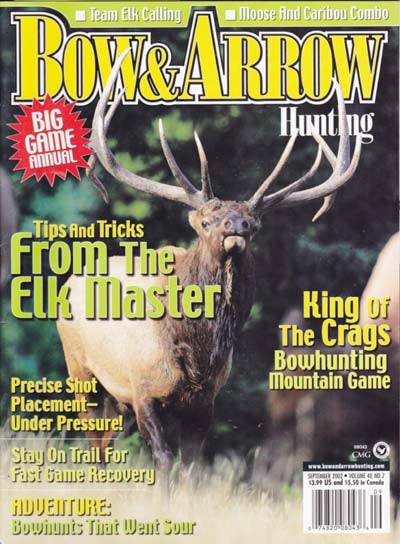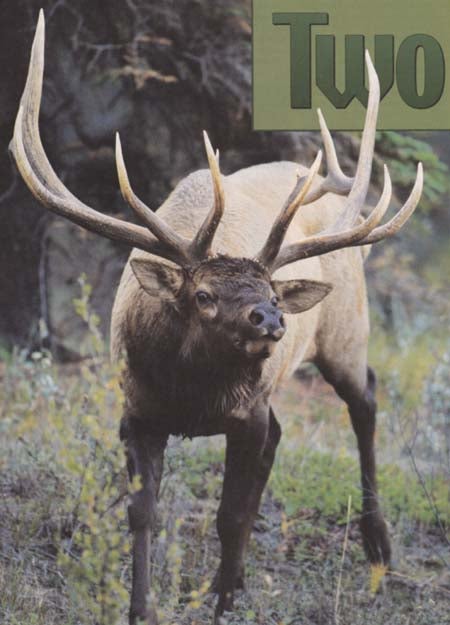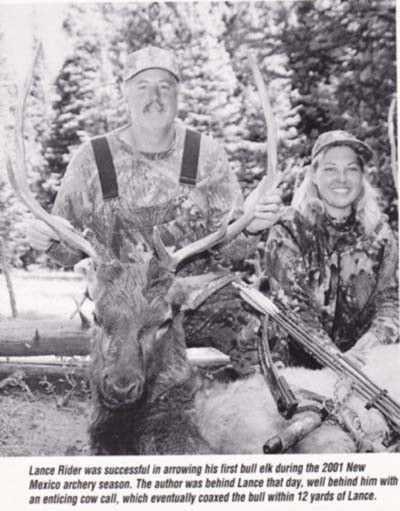Published by archerchick on 20 Feb 2010 at 11:51 pm
Two Is A Charm – by Kathy Butt
Two Is A Charm -By Kathy Butt
Those serious about tagging and archery bull will be sure to take a partner along
http://www.bowandarrowhunting.com
Any hunter who has experienced an up-close-and-personal encounter with a screaming, slobbering, pissing-all-over-himself bull elk will have a vivid memory of that encounter etched forever in their heart and soul.
There’s no doubt about it. It’s quite addictive. And it’s encounters such as the one I just described, that I look forward to each elk season with great anticipation. In fact, I experienced one of those up-close encounters just this past fall.
It was during the second week of the New Mexico archery elk season when my husband, Foster, and I moved in tight to work a very vocal bull in the dark timber early one morning. After making a mad dash up the wet and slippery mountainside, we caught a glimpse of the bull as he ran from one ridge to another. And although this bull was extremely vocal, he was
playing hard to get. Actually, it after closing the distance for the third time that I finally was in th right position and ready for the shot as the bull came charging down the ridge ahead.
Foster had backed up behind me 125 to 150 yards and his realistic and urgent cow calling sequence was working like a charm. The bull just couldn’t stand it any longer and came racing down the ridge ahead. I drew my bow as he threw his head back and charged down the game trail into the open meadow 25 yards away. He stopped broadside and looked in my direction, but it was too later. I was sighted in, my top pin positioned low and behind his front shoulder. I touched the trigger of my release and watched as the white fletchings of my arrow disappeared into the bull’s chest.
The 6×6 bolted up the ridge to my right and I bugled just as he reached the edge of the dark timber. This was hopefully to confuse the bull, so he wouldn’t travel far before going down, but also to signal Foster that I’d shot the bull. I was experiencing and absolute whirlwind of emotion, my knees were shaking uncontrollably, and I was trying to gain my composure as Foster carefully and quietly worked his way back to me. Just as Foster arrived, we heard the bull crash in the timber. The bull was down. We faintly heard the bull taking his last laboring breaths, and tears were sliding down my cheeks as my hunting partner smiled at me and gave me a victorious thumbs up!
Thirty minutes later, Foster and I cautiously approached the bull. I couldn’t help but think of how other successful encounters such as this one confirmed what we’d known for many years-that teaming up with a hunter partner tremendously increases a hunter’s shooting opportunities.
There’s no question, teaming up with a hunting buddy and taking turns calling backup for each other can greatly increase your odds of calling bulls into shooting range, rather than you just calling solo. It doesn’t have anything to do with the vocal rate of today’s elk, for I believe elk are just as vocal now as when my husband and I first began hunting them back in the 1980s. But, I do believe that calling elk into bow range has become increasingly difficult, or let’s say perhaps more of a challenge now than when hunters first incorporated bugling and cow-calling tactics into their hunting strategies.
My husband and I have been running a private-land elk hunting operation in northern New Mexico since the mid-1980s and have discovered through our own personal experiences, as hunters and guides, that hunting with a partner, and having them call behind you as much as 50 to 150 yards, will increase your shooting opportunities by almost 100 percent.
The 6×6 bull mentioned in the beginning of this article is not the first bull my husband has called into archery range for me. Another prime example of how productive tag-team hunting can be is the day I called in a 5×5 bull for one of our guided hunters during the third week of the New Mexico archery season. This incident occurred just last fall. I was guiding a first-time elk hunter, Lance Rider, a good friend of ours from Tennessee, when we located a bull that seemed to be real excited. He was quite vocal and we didn’t hear or see any cows. Having worked a bull in this same area the day before, one that had a small harem of cows with him-particularly one very bossy lead cow that yanked the bull’s chain and convinced him to follow her in the other direction-I felt we should slip in as close as possible before making a sound. I explained to Lance that I was going to back up and call in hopes of pulling the screaming bull upwind of him. I then told Lance to move in as tight on the bull as he felt he could without being detected. Then I told him to keep his eyes open and be ready for a shot.
This bull was ripe for the picking and our strategies worked like a charm. Lance was able to slip through the timber undetected, moving quickly and carefully while weaving his way through the shadows of the dark timber. He hadn’t gone far before the 5×5 came charging in and was looking for the cows that seemed to be moving in the other direction. Lance was drawn and ready when the bull stopped 12 yards away to bugle. I was positioned almost 100 yards slightly to the right of Lance’s setup and couldn’t see a darned thing, but when the bull bugled that last time, I knew he had to be right on top of Lance. Almost immediately I caught a glimpse of the bull running through the timber and heard him stumble less than75 yards from where I stood. Oh, what I would give to have seen the look on Lance’s face when that bull stopped and bugled right in front him!
Setting Up for Success
Using the proper setup is the key to not only calling a bull into range for the shooter, but is also crucial for calling a bull upwind and broadside of the shooter, which is what you want. And always check the wind before ever moving in to set up on a bugling bull and position the designated shooter in front of, not behind, a large tree or bush. Standing behind something, as well as shooting from a kneeling position, somewhat limits your shooting opportunities.
The caller should back away from the shooter’s setup a few yards, angle slightly to one side (upwind of the shooter) and then call. Move another 25 to 50 yards and call again, making noise as you move away. Elk make a lot of noise when moving through timber, so kick rocks, step on branches, do anything that will further convince a bull there are other elk in the area.
The shooter should keep a mouth diaphragm in his mouth in order to stop a bull for the shot.
Suggested Calling Strategies
Your elk-calling strategies will vary throughout the season and here’s what I ve found to work best during the various stages of the elk rut. Bulls aren’t very vocal during early September, so I’d suggest bugling only to locate a bull and then switch to using only soft cow mews. As the season
progresses and the first cows start coming into estrous, then use a bugle more, but still mostly to locate a bull. Even when we use a bugle call, my husband and I prefer to tone it down and sound like a young bull.
As the rut commences we then switch to using whinny, aggressive-type cow calls, calls which create a sense of urgency or pleading. And what we’ve found to be especially effective is to use two different types (brands) of these calls, making it appear as if there are two or more cows begging for company. This technique works especially well toward the end of the archery season. when the bulls are screaming non-stop. There are many styles available, including open-reed (mouth calls) and hand-operated mechanical-type calls, and most manufacturers offer instructional audio cassettes to teach the proper techniques for using them.
This demanding, whinny-type call may sometimes even entice the bull’s harem right into your lap.
No, it doesn’t always work, but on numerous occasions I’ve been able to get the cows all worked up. They come in to investigate the source of the call and the bull comes following close behind. The key to using this type of call is attaining the right pitch and the sense of urgency with which you apply it. I will also warn you that we’ve had black bears come to this call as well. In fact, we’ve had bears run in behind a bull on two separate occasions. So, be aware of that possibility.
As for bugling, we all enjoy sounding like the biggest, baddest bull of the woods, but throughout our years of guiding elk hunters, we’ve found it best to use bugles sparingly, mostly to locate bulls. There are occasions when a bull seems to respond well to bugles, and when it’s then, we keep the volume down and the bugle short. You’re more likely to call in a bull that doesn’t feel as though he’s going to get his butt kicked by a bigger bull, so keep your bugle weak and short.
If you plan on heading west rhis September to hunt elk, consider buddying-up for bulls. You’ll be amazed at how this tag-team hunting will tremendously increase your shooting opportunities. <—<<
Archived by
ARCHERYTALK.COM
all rights reserved
Leave a Reply
You must be logged in to post a comment.







 Your Privacy Choices
Your Privacy Choices